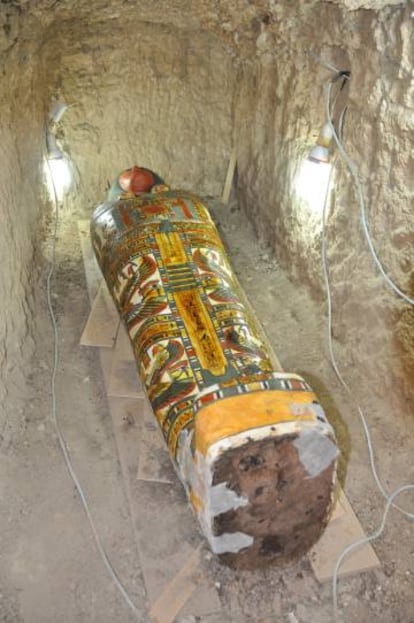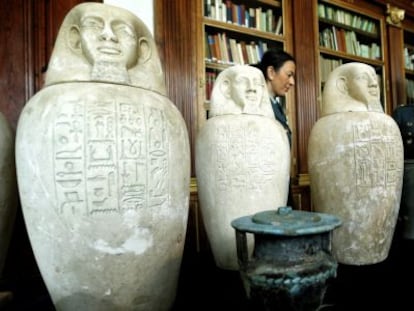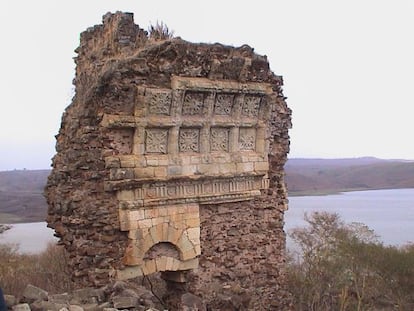Spanish-led mission finds mummy near Egyptian pharaoh’s temple
Myriam Seco’s team uncovers coffin of high-ranking official at Thutmosis III sanctuary in Luxor


While media attention in Egypt typically focuses on the mysterious empty spaces within the Great Pyramid or on Tutankhamun’s tomb, archeologists continue their patient and often unreported work at sites across the country.
This meticulous labor turns up finds that advance scientific knowledge about Ancient Egypt, and sometimes the finds are spectacular.
Take the recent discovery by a mission led by Spanish Egyptologist Myriam Seco at the site of the funerary temple of Thutmose III, within the Theban Necropolis on the west bank of the Nile, opposite modern-day Luxor.
Beyond the outer wall of the temple built for the powerful warring pharaoh (known as the Egyptian Napoleon), in the southern zone, archeologists digging inside a shallow well discovered a niche holding a wooden sarcophagus.
Inside was a mummy, held within a beautifully decorated, human-shaped cardboard coffin. While the sarcophagus itself had been badly damaged by termites and could not be fully salvaged, the cardboard coffin “is in a good state of conservation and beautiful images in striking colors can be seen,” said Seco, speaking from Luxor.
Once the temple was left to ruin, the place continued to function as a necropolis Myriam Seco, archeologist
Scientists have managed to identify the individual who was buried there: a government employee named Amon Renef, described as a servant of the royal household. Preliminary studies place the burial in the early Third Intermediate Period, around the 11th or 10th century BCE.
The mulitcolored coffin contains several religious and symbolic items, including the winged solar disk and the cobra; the protective goddesses Isis and Nephthys; the four sons of Horus, who watched over the deceased’s organs, along with protective falcons with outstretched wings.
As for the mummy, “we will analyze it next week with a scanner and X-rays to identify its physical traits and try to ascertain the cause of death and to determine whether it is wearing jewels or amulets,” said Seco.
The find is part of the ninth campaign of archeological work at the temple of Thutmose III, where scientists are trying to restore the long-abandoned site to its original glory and to locate other tombs from different time periods.
The deceased was a government worker named Amon Renef, described as a servant of the royal household
“We knew that the temple was built over an earlier necropolis from the Middle Period, with burials of people from the upper social class,” sais Seco. “Two years ago we found another necropolis by the northern wall for lower-class people, which also predates the temple. And at the end of the last season we found two late-period tombs to the west of the compound. Now we have found this in the south, which proves that once the temple was abandoned and left to ruin, the place continued to function as a necropolis.”
The mission was made possible by the joint cooperation of the Egyptian Ministry for Antiquities, the Seville-based Academy of Fine Arts Santa Isabel de Hungría, the Botín Foundation, Santander Bank, Cemex and Cajasol.
Asked about the current situation in Luxor, where visitor numbers have declined in recent years due to the terrorism threat, Seco says that tourism seems to be on the rise again.
“Things are starting to move, there is more hope. We are seeing more buses go by.”
English version by Susana Urra.
Tu suscripción se está usando en otro dispositivo
¿Quieres añadir otro usuario a tu suscripción?
Si continúas leyendo en este dispositivo, no se podrá leer en el otro.
FlechaTu suscripción se está usando en otro dispositivo y solo puedes acceder a EL PAÍS desde un dispositivo a la vez.
Si quieres compartir tu cuenta, cambia tu suscripción a la modalidad Premium, así podrás añadir otro usuario. Cada uno accederá con su propia cuenta de email, lo que os permitirá personalizar vuestra experiencia en EL PAÍS.
¿Tienes una suscripción de empresa? Accede aquí para contratar más cuentas.
En el caso de no saber quién está usando tu cuenta, te recomendamos cambiar tu contraseña aquí.
Si decides continuar compartiendo tu cuenta, este mensaje se mostrará en tu dispositivo y en el de la otra persona que está usando tu cuenta de forma indefinida, afectando a tu experiencia de lectura. Puedes consultar aquí los términos y condiciones de la suscripción digital.
More information
Últimas noticias
The complicated life of Francesca Albanese: A rising figure in Italy but barred from every bank by Trump’s sanctions
How Japan is trying to avert ‘digital defeat’
Reinhard Genzel, Nobel laureate in physics: ‘One-minute videos will never give you the truth’
Pinochet’s victims grapple with José Antonio Kast’s rise in Chile
Most viewed
- Pablo Escobar’s hippos: A serious environmental problem, 40 years on
- Why we lost the habit of sleeping in two segments and how that changed our sense of time
- Trump’s obsession with putting his name on everything is unprecedented in the United States
- The Florida Keys tourist paradise is besieged by immigration agents: ‘We’ve never seen anything like this’
- Charles Dubouloz, mountaineering star, retires at 36 with a farewell tour inspired by Walter Bonatti










































